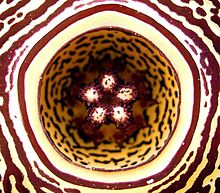Edithcolea grandis
| Edithcolea grandis | ||||||||||||
|---|---|---|---|---|---|---|---|---|---|---|---|---|

Edithcolea grandis ("var. Baylissiana ") |
||||||||||||
| Systematics | ||||||||||||
|
||||||||||||
| Scientific name of the genus | ||||||||||||
| Edithcolea | ||||||||||||
| NEBr. | ||||||||||||
| Scientific name of the species | ||||||||||||
| Edithcolea grandis | ||||||||||||
| NEBr. |
Edithcolea grandis is the only species of the monotypical genus Edithcolea . It is fairly isolated in the tribe Stapeliinae in the subfamily of the silk plants (Asclepiadoideae) within the family of the dog poison plants (Apocynaceae). It is named after Edith Cole (1859–1940), a British plant collector.
features
Edithcolea grandis forms perennial, stem-succulent , prostrate , ascending, strongly branched shoots. They reach heights of growth of up to 10 cm and a diameter of 1 to 1.5 cm. They are rounded with four to five ribs in cross section. The ribs are sometimes screwed. The surface is bare and brown-olive in color. The z. T. linear, z. Conical warts, some of which are offset, have apically pointed, hard and persistent thorns.
The inflorescence usually consists of only one flower that appears on the upper parts of the shoot. The flower stalk is bare, up to 23 mm long and measures up to 3.5 mm in diameter. The hermaphroditic, radially symmetrical , five-fold flower is flat and about 8 to 12.5 cm in diameter. The oval with lanceolate and pointed sepals (sepals) measure 5 to 9 mm × 1.5 to 3 mm and thus they are shorter than the corolla tube. The crown is olive-green on the outside, pale yellow on the inside with numerous purple-brown dots and spots. The corolla tube is bowl-shaped (approx. 6 mm × 6 mm), the edge slightly domed. Inside there are fine warts on concentric, somewhat raised purple-brown rings. The crown lobes are broadly rounded (3.5 to 5 cm × 2.5 to 3 cm) with one apical tip each. The upper half of the crown lobes is dark brown to olive green and smooth. Zones with brown club hair run arc-shaped across the center of the corolla lobes and along the lower edges. Five further bands with brown club hair run radially from the edge of the corolla tube towards the incisions of the corolla lobes. The secondary crown is double-rowed and yellowish. The interstaminal coronary lobes are rounded square or transversely rectangular. They form basal pockets and are finely haired. The staminal corolla lobes lie on the stamens . They are apically widened triangular and overlap laterally. Dorsally, they have fine spines or warts. The stamens are triangular, the pollinia relatively large.
The fruits are follicle-like follicles . The oval, light brown, about 6 mm × 4 mm measuring seeds have a tuft of hair with a diameter of 25 to 30 mm.
distribution
Edithcolea grandis occurs in Ethiopia , Somalia , Kenya , Uganda , Tanzania and on the island of Socotra . The first description was in 1895 by Nicholas Edward Brown .
Synonymy
A second species was originally added to the genus Edithcolea , Edithcolea sordida N.E.Br. which is now regarded as a synonym for Edithcolea grandis . The variety Edithcolea grandis var. Baylissiana established by Lavranos and Hardy in 1963 is not recognized as such by Müller & Albers (in Albers & Meve, 2002).
literature
- Focke Albers and Ulli Meve (eds.): Succulent lexicon Volume 3 Asclepiadaceae (silk plants) . Ulmer, Stuttgart 2002, 322 pages, ISBN 978-3-8001-3982-8 .
- Sigrid Liede-Schumann and Ulrich Meve: The Genera of Asclepiadoideae, Secamonoideae and Periplocoideae (Apocynaceae) : Edithcolea - online. (English)
Individual evidence
- ↑ Lotte Burkhardt: Directory of eponymous plant names . Extended Edition. Botanic Garden and Botanical Museum Berlin, Free University Berlin Berlin 2018. [1]
- ^ Bulletin of Miscellaneous Information, Royal Gardens, Kew. Kew, 1895, p. 220. online

